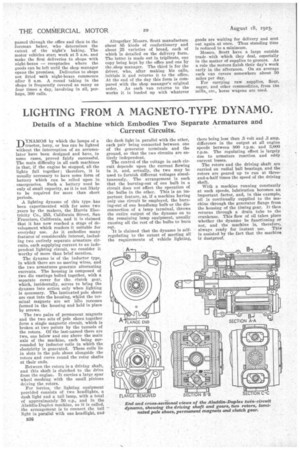LIGHTING FROM A MAGNETO-TYPE DYNAMO.
Page 20

If you've noticed an error in this article please click here to report it so we can fix it.
Details of a Machine which Embodies Two Separate Armatures and Current Circuits.
JJYNAMOS by which the lamps of a tractor, lorry, or bus can be lighted without the interception of an accumulator have been designed and have, in
some cases, proved fairly successful. The main difficulty in all such machines is that, if the engine be stopped, all the lights fail together ; therefore, it is usually necessary to have some form of battery which can be relied upon in emergencies. Such a battery need be only of small capacity, as it is not likely to be required for more than short periods.
A lighting dynamo of this type has been experimented with for some two years by the makers, the Harris Elec tricity Co., 255, California Street, San Francisco, California, and it is claimed that it has now reached a stage of de velopment which renders it suitable for everyday use. As it embodies many features of considerable interest, including two entirely separate armature circuits, each supplying current to an independent lighting circuit, we consider it worthy of more than brief mention.
The dynamo is of the inductor type, in which there are no moving wires, and the two armatures generate alternating currents. The housing is composed of two die castings bolted together, with a separate cover for the clutch gear, which, incidentally, serves to bring the dynamo into action only when lighting is necessary. The laminated pole shoes are cast into the housing, whilst the terminal magnets are set ifito recesses formed in the housing and held in place by screws.
The two pairs of permanent Magnets and the two sets of pole shoes together form a single magnetic circuit, which is broken at two points by the tunnels of the rotors. Of the last-named there are two, one below and one above the main axis of the machine, each being surrounded by inductor coils in which the electricity is generated. These coils lie in slots in the pole shoes alongside the rotors and curve round the rotor shafts at their ends.
Between the rotors is a driving shaft, and this shaft is clutched to the drive from the engine. It carries a large spur wheel meshing with the small pinions driving the rotors.
For lorries, the lighting equipment provided consists of two headlights, a dash light and a tail lamp, with a total of approximately 50 c.p., and in -the Aladdin-Duplex machine, as it is called, the arrangement is to connect the tail light in parallel with one headlight, and
the dash light in parallel with the other, each pair being connected between one of the generator terminals and the ground, so that the two circuits are entirely independent.
The control of the voltage in each circuit depends upon the current flowing in it, and, actually, the two may be used to furnish different voltages simultaneously. The arrangement is such that the burning-out of one bulb in a circuit does not affect the operation of the bulbs in the other. This is an important feature, tut, if a machine having only one circuit be employed, the burning-out of one headlamp bulb or the disconnection of a lamp terminal, throws the entire output of the dynamo on to the remaining lamp equipment, usually causing all the rest of the bulbs to burn out.
"It is claimed that the dynamo is selfregulating to the extent of meeting all the requirements of vehiclelighting, there being less than .5 volt and .3 amp. difference in the output at all engine speeds between 890 r.p.m. and 3,000 r.p.m. The regulating effect is largely due to armature reaction and eddy current losses.
The rotors and the driving shaft are carried on radial ball bearings, and the• rotors are geared up to run at threeand-a-half times the speed of the driving shaft.
With a machine running constantly at such speeds, lubrication becomes an important factor, and, in this example, oil is continually supplied to the machine through the generator flange from the housing of the timing gear. It then returns through a drain tube to the crankcase. This flow of oil takes place whether the dynamo be functioning or not, and the machine is, therefore,. always ready for instant use. This is assisted by the fact that the machine. ig dustproof.




























